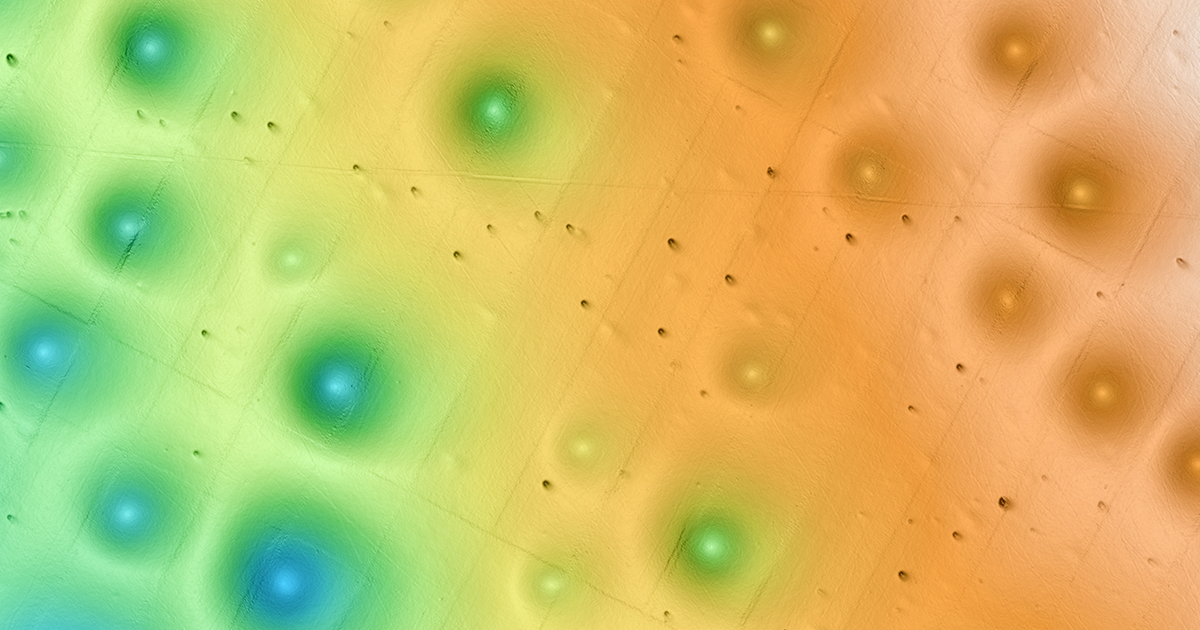New MBARI research on a field of pockmarks—large, circular depressions on the seafloor—offshore of Central California has revealed that powerful sediment flows, not methane gas eruptions, maintain these prehistoric formations. A team of researchers from MBARI, the United States Geological Survey (USGS), and Stanford University published their findings in the Journal of Geophysical Research: Earth Surface. This work provides important information to guide decision-making about responsible use and management of the seafloor off California, including site assessments for the development of offshore wind farms.
The Sur Pockmark Field—an area about the size of the city of Los Angeles that is located off the coast of Big Sur, California—contains more than 5,200 circular depressions. These formations are approximately 200 meters (656 feet) across, roughly the distance of two football fields, and five meters (16 feet) deep. Past research in other parts of the world has suggested that similar large seafloor depressions were formed and maintained by methane gas bubbling up through the sediments. With wind farms slated for construction offshore of Central California, resource managers were concerned about how the presence of methane gas might impact the stability of the seafloor in this region.
The data collected by MBARI researchers and their collaborators found no evidence of methane at this site. Instead, the research team has proposed that sediment gravity flows—similar to an avalanche of mud, sand, and water moving along the seafloor—that have occurred in this region intermittently for hundreds of thousands of years maintain these seafloor formations.
“There are many unanswered questions about the seafloor and its processes,” said MBARI Senior Research Technician Eve Lundsten, who led this work. “This research provides important data about the seafloor for resource managers and others considering potential offshore sites for underwater infrastructure to guide their decision-making.”
The research team deployed MBARI’s advanced underwater robots to study the Sur Pockmark Field. First, autonomous underwater vehicles (AUVs)—torpedo-shaped, self-guided robots—mapped the region. Previous maps of the seafloor were collected by sonar mounted on ships, but the distance between the ocean surface and the seafloor resulted in low-resolution data. AUVs can travel closer to the seafloor to visualize the terrain below in much greater detail. MBARI’s seafloor mapping AUVs also carried technology to profile the sub-bottom layers of sediment below the seafloor. These maps then guided sampling with MBARI’s remotely operated vehicle (ROV) Doc Ricketts. Operated by the research team in the control room aboard an MBARI research vessel, the ROV Doc Ricketts collected sediment samples to reconstruct the history of individual pockmarks.
These pockmarks are located on the continental margin, a dynamic section of the seafloor that connects the relatively shallow continental shelf to the deep sea. Sediment gravity flows can move massive amounts of material through this region intermittently. The data and samples collected by MBARI technology helped the research team piece together the history of sediment movements over this part of the seafloor.
The team found multiple layers of sandy deposits, called turbidites, in the sediment samples taken from the pockmarks and the sub-bottom images of the pockmark field. These deposits indicated that large sediment gravity flows in the region have occurred intermittently for at least the last 280,000 years. These sediment gravity flows appear to cause erosion in the center of each pockmark, maintaining these unique underwater morphologic features over time.
“We collected a massive amount of data, allowing us to make a surprising link between pockmarks and sediment gravity flows. We were unable to determine exactly how these pockmarks were initially formed, but with MBARI’s advanced underwater technology, we’ve gained new insight into how and why these features have persisted on the seafloor for hundreds of thousands of years,” said Lundsten.
Seafloor pockmarks have been found elsewhere around the world. In those locations, pockmarks have been associated with the release of methane gas or other fluids from the seafloor. Bubbling methane could potentially cause the seafloor to be unstable, which could pose risks for structures on the seafloor, like the anchors for offshore wind turbines. In October 2018, the US Bureau of Ocean Energy Management (BOEM) announced areas offshore of Central California for potential wind energy leasing. MBARI quickly moved to conduct this research to answer critical questions about the stability of the seafloor to guide development of offshore wind energy in California.
“Expanding renewable energy is critical to achieving the dramatic cuts in carbon dioxide emissions needed to prevent further irreversible climate change. However, there are still many unanswered questions about the possible environmental impacts of offshore wind energy development,” said MBARI President and CEO Chris Scholin. “This research is one of many ways that MBARI researchers are answering fundamental questions about our ocean to help inform decisions about how we use marine resources.”
Because of the extensive efforts of MBARI, USGS, BOEM, and NOAA as part of the interagency Expanding Pacific Research and Exploration of Submerged Systems (EXPRESS) cooperative research campaign, the Sur Pockmark Field is now one of the best-studied areas of seafloor on the west coast of North America. However, there are still many questions to answer about these pockmarks, including how these features were initially formed hundreds of thousands of years ago.
Funding for this work was provided by the David and Lucile Packard Foundation, BOEM, and USGS.



